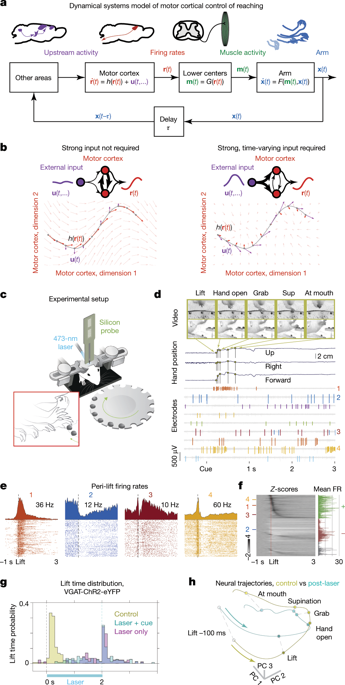Our official English website, www.x-mol.net, welcomes your
feedback! (Note: you will need to create a separate account there.)
Cortical pattern generation during dexterous movement is input-driven
Nature ( IF 50.5 ) Pub Date : 2019-12-25 , DOI: 10.1038/s41586-019-1869-9 Britton A Sauerbrei 1 , Jian-Zhong Guo 1 , Jeremy D Cohen 1 , Matteo Mischiati 1 , Wendy Guo 1 , Mayank Kabra 1 , Nakul Verma 2 , Brett Mensh 1 , Kristin Branson 1 , Adam W Hantman 1
Nature ( IF 50.5 ) Pub Date : 2019-12-25 , DOI: 10.1038/s41586-019-1869-9 Britton A Sauerbrei 1 , Jian-Zhong Guo 1 , Jeremy D Cohen 1 , Matteo Mischiati 1 , Wendy Guo 1 , Mayank Kabra 1 , Nakul Verma 2 , Brett Mensh 1 , Kristin Branson 1 , Adam W Hantman 1
Affiliation

|
The motor cortex controls skilled arm movement by sending temporal patterns of activity to lower motor centres 1 . Local cortical dynamics are thought to shape these patterns throughout movement execution 2 – 4 . External inputs have been implicated in setting the initial state of the motor cortex 5 , 6 , but they may also have a pattern-generating role. Here we dissect the contribution of local dynamics and inputs to cortical pattern generation during a prehension task in mice. Perturbing cortex to an aberrant state prevented movement initiation, but after the perturbation was released, cortex either bypassed the normal initial state and immediately generated the pattern that controls reaching or failed to generate this pattern. The difference in these two outcomes was probably a result of external inputs. We directly investigated the role of inputs by inactivating the thalamus; this perturbed cortical activity and disrupted limb kinematics at any stage of the movement. Activation of thalamocortical axon terminals at different frequencies disrupted cortical activity and arm movement in a graded manner. Simultaneous recordings revealed that both thalamic activity and the current state of cortex predicted changes in cortical activity. Thus, the pattern generator for dexterous arm movement is distributed across multiple, strongly interacting brain regions. The complex patterns of activity in motor cortex that control movements such as reach and grasp are dependent on both upstream neuronal activity in the thalamus and the current state of the cortex.
中文翻译:

灵巧运动过程中的皮质模式生成是输入驱动的
运动皮层通过将活动的时间模式发送到较低的运动中心 1 来控制熟练的手臂运动。局部皮层动力学被认为在整个运动执行过程中塑造这些模式 2 – 4 。外部输入与设置运动皮层 5 、 6 的初始状态有关,但它们也可能具有模式生成作用。在这里,我们剖析了局部动力学和输入对小鼠抓取任务期间皮质模式生成的贡献。将皮层扰动到异常状态会阻止运动启动,但在扰动被释放后,皮质要么绕过正常的初始状态并立即生成控制到达的模式,要么无法生成此模式。这两个结果的差异可能是外部输入的结果。我们通过使丘脑失活来直接研究输入的作用;在运动的任何阶段,这种扰乱的皮层活动和肢体运动学都会受到干扰。以不同频率激活丘脑皮层轴突末端会以分级方式破坏皮层活动和手臂运动。同时记录显示,丘脑活动和皮层的当前状态都预测了皮层活动的变化。因此,灵巧手臂运动的模式发生器分布在多个相互作用强烈的大脑区域。运动皮层中控制诸如伸手和抓握等运动的复杂活动模式取决于丘脑中的上游神经元活动和皮层的当前状态。在运动的任何阶段,这种扰乱的皮层活动和肢体运动学都会受到干扰。以不同频率激活丘脑皮层轴突末端会以分级方式破坏皮层活动和手臂运动。同时记录显示,丘脑活动和皮层的当前状态都预测了皮层活动的变化。因此,灵巧手臂运动的模式发生器分布在多个相互作用强烈的大脑区域。运动皮层中控制诸如伸手和抓握等运动的复杂活动模式取决于丘脑中的上游神经元活动和皮层的当前状态。在运动的任何阶段,这种扰乱的皮层活动和肢体运动学都会受到干扰。以不同频率激活丘脑皮层轴突末端会以分级方式破坏皮层活动和手臂运动。同时记录显示,丘脑活动和皮层的当前状态都预测了皮层活动的变化。因此,灵巧手臂运动的模式发生器分布在多个相互作用强烈的大脑区域。运动皮层中控制诸如伸手和抓握等运动的复杂活动模式取决于丘脑中的上游神经元活动和皮层的当前状态。同时记录显示,丘脑活动和皮层的当前状态都预测了皮层活动的变化。因此,灵巧手臂运动的模式发生器分布在多个相互作用强烈的大脑区域。运动皮层中控制诸如伸手和抓握等运动的复杂活动模式取决于丘脑中的上游神经元活动和皮层的当前状态。同时记录显示,丘脑活动和皮层的当前状态都预测了皮层活动的变化。因此,灵巧手臂运动的模式发生器分布在多个相互作用强烈的大脑区域。运动皮层中控制诸如伸手和抓握等运动的复杂活动模式取决于丘脑中的上游神经元活动和皮层的当前状态。
更新日期:2019-12-25
中文翻译:

灵巧运动过程中的皮质模式生成是输入驱动的
运动皮层通过将活动的时间模式发送到较低的运动中心 1 来控制熟练的手臂运动。局部皮层动力学被认为在整个运动执行过程中塑造这些模式 2 – 4 。外部输入与设置运动皮层 5 、 6 的初始状态有关,但它们也可能具有模式生成作用。在这里,我们剖析了局部动力学和输入对小鼠抓取任务期间皮质模式生成的贡献。将皮层扰动到异常状态会阻止运动启动,但在扰动被释放后,皮质要么绕过正常的初始状态并立即生成控制到达的模式,要么无法生成此模式。这两个结果的差异可能是外部输入的结果。我们通过使丘脑失活来直接研究输入的作用;在运动的任何阶段,这种扰乱的皮层活动和肢体运动学都会受到干扰。以不同频率激活丘脑皮层轴突末端会以分级方式破坏皮层活动和手臂运动。同时记录显示,丘脑活动和皮层的当前状态都预测了皮层活动的变化。因此,灵巧手臂运动的模式发生器分布在多个相互作用强烈的大脑区域。运动皮层中控制诸如伸手和抓握等运动的复杂活动模式取决于丘脑中的上游神经元活动和皮层的当前状态。在运动的任何阶段,这种扰乱的皮层活动和肢体运动学都会受到干扰。以不同频率激活丘脑皮层轴突末端会以分级方式破坏皮层活动和手臂运动。同时记录显示,丘脑活动和皮层的当前状态都预测了皮层活动的变化。因此,灵巧手臂运动的模式发生器分布在多个相互作用强烈的大脑区域。运动皮层中控制诸如伸手和抓握等运动的复杂活动模式取决于丘脑中的上游神经元活动和皮层的当前状态。在运动的任何阶段,这种扰乱的皮层活动和肢体运动学都会受到干扰。以不同频率激活丘脑皮层轴突末端会以分级方式破坏皮层活动和手臂运动。同时记录显示,丘脑活动和皮层的当前状态都预测了皮层活动的变化。因此,灵巧手臂运动的模式发生器分布在多个相互作用强烈的大脑区域。运动皮层中控制诸如伸手和抓握等运动的复杂活动模式取决于丘脑中的上游神经元活动和皮层的当前状态。同时记录显示,丘脑活动和皮层的当前状态都预测了皮层活动的变化。因此,灵巧手臂运动的模式发生器分布在多个相互作用强烈的大脑区域。运动皮层中控制诸如伸手和抓握等运动的复杂活动模式取决于丘脑中的上游神经元活动和皮层的当前状态。同时记录显示,丘脑活动和皮层的当前状态都预测了皮层活动的变化。因此,灵巧手臂运动的模式发生器分布在多个相互作用强烈的大脑区域。运动皮层中控制诸如伸手和抓握等运动的复杂活动模式取决于丘脑中的上游神经元活动和皮层的当前状态。











































 京公网安备 11010802027423号
京公网安备 11010802027423号